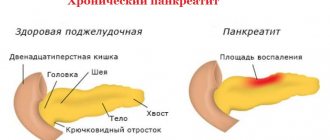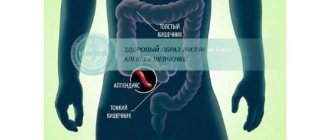Expectant mothers usually associate abdominal pain with pregnancy. In most cases this is true. This is why it is possible to miss the symptoms of appendicitis during pregnancy. To prevent this from happening, you need to know how this insidious disease manifests itself.
Appendicitis, or inflammation of the appendix, is one of the most common diseases of the abdominal organs. Among women with appendicitis, it occurs in up to 3-3.5% of pregnant women. The incidence of acute appendicitis in pregnant women is slightly higher than in other women.
The exact causes of appendicitis are not fully known. There are several versions. According to one of them, it is believed that the development of appendicitis is directly related to blockage of the lumen between the cecum and the appendix. Blockage can occur due to the formation of small fecal stones - coprolites, which close the lumen, thereby disrupting the blood supply in the appendix, which leads to its swelling and inflammatory manifestations.
Pregnancy may be a predisposing factor for the development of appendicitis. This is explained by the growth and enlargement of the uterus, which, taking up more and more space in the pelvis, compresses the appendix, disrupting its blood supply, which leads to the development of inflammation.
Symptoms of appendicitis during pregnancy
There are simple (i.e. catarrhal) and destructive (phlegmonous, gangrenous and perforated) forms of appendicitis. All of them are stages of the development of a single process, and for their occurrence during the progressive course of the disease a certain time is necessary: for catarrhal appendicitis (when only the mucous membrane of the appendix is involved in the inflammation process) - 6-12 hours, for phlegmonous (changes can be traced on the mucous, submucosal and partially on the muscle layer) - 12-24 hours, for gangrenous (when all layers of the wall of the appendix die off) - 24-48 hours: later perforation of the appendix may occur, in which the intestinal contents enter the abdominal cavity.
Manifestations of appendicitis largely depend on pathological changes in the appendix, as well as on its location in the abdominal cavity. As long as the inflammatory process is limited to the appendix itself, without moving to the peritoneum - the layer of connective tissue covering the walls and organs of the abdominal cavity - the manifestations of the disease do not depend on the location in the abdominal cavity relative to other organs and are expressed by pain in the upper third of the abdomen, which gradually shift down to the right half of the abdomen. This may cause nausea and vomiting. Abdominal pain can be minor and occur not only in the right iliac region, but also in other parts of the abdomen. Often, pain upon examination is not immediately detected and is detected much higher than the uterus; often the greatest pain is detected in the right lumbar region. Characteristically, the pain intensifies when lying on the right side, due to the pressure of the pregnant uterus on the inflamed area.
With further development of the inflammatory process, pain appears in the right iliac region - in the lower abdomen or higher, up to the hypochondrium, depending on the degree of displacement of the appendix by the uterus, that is, on the duration of pregnancy. Symptoms of peritoneal irritation (pain when suddenly removing the hand pressing on the anterior abdominal wall) are absent in pregnant women or are mild due to stretching of the abdominal wall. In pregnant women, all symptoms may be mild and appear late.
Other features of appendicitis include the atypical location of the appendix. So, with a “high” location of the appendix (under the liver), symptoms of gastritis may appear with pain in the upper abdomen, nausea, and vomiting. With a “low” location (in the pelvis), especially if the appendix borders the bladder, a picture of cystitis may be observed - inflammation of the bladder, with pain radiating to the leg, perineum, with frequent urination in small portions.
The development of appendicitis in pregnant women also affects the fetus, especially if appendicitis develops in the second trimester of pregnancy. The most common complication of pregnancy is the threat of termination. Other complications include postoperative infectious processes and intestinal obstruction. In rare cases, premature detachment of a normally located placenta occurs, when the placenta detaches from the wall of the uterus over a more or less extended area. In this situation, the prognosis depends on the degree of detachment - with a small detachment and timely treatment, pregnancy can be saved. Chorioamnionitis (inflammation of the membranes) and intrauterine infection of the fetus require antibacterial therapy.
The likelihood of complications is especially high during the first week after surgery. In this regard, all patients after appendectomy are prescribed drugs that relax the muscles of the uterus. To prevent infectious complications after appendectomy in pregnant women, all patients are prescribed antibiotics.
Symptoms
Symptoms of appendicitis during pregnancy appear with a certain specificity. The location and severity of sensations vary depending on the period. At 3-6 months, appendicitis during pregnancy causes pain in the liver area; in the third month, symptoms of discomfort appear under the ribs. The main disturbing manifestations are cramping, sharp pain attacks in the right side. Appendicitis during pregnancy also has other symptoms: nausea, diarrhea, vomiting, and an increase in temperature to low-grade levels.
There are also some tests that confirm the appearance of appendicitis:
- persistence of discomfort when turning from the left side to the right (Taranenko's symptom);
- localization of pain on the right when pressing on the left rib (Brendo's symptom);
- the pain intensifies when lifting and holding the right lower limb straight at the knee in a standing or lying position (Obraztsov’s symptom);
- the intensity of discomfort increases when lying on the right side (Michelson's symptom).
Additional manifestations of the pathology may be: frequent, painful urination, shortness of breath, tachycardia, bloating.
If you suspect inflammation of the appendix, it is prohibited:
- warm the abdominal area - the procedure activates the pathological process;
- use antispasmodics and painkillers - making a diagnosis becomes more difficult; upon palpation by a specialist, there will be no adequate response;
- Take food and fluids - appendix removal must be done on an empty stomach.
Following these recommendations will speed up the diagnostic process and also help the specialist choose an effective treatment method.
An excursion into anatomy
The appendix (Latin appendix - “adjacent”) is a vermiform appendix. It is a hollow tube that ends blindly on one side and adjacent to the cecum on the other. In most cases, the appendix is located in the lower abdomen on the right, but quite often there are atypical forms of location of the appendix, when it can descend into the pelvis or, conversely, ascend to the liver. Such atypical forms of the location of the appendix can lead to difficulties in diagnosing its inflammation.
What is appendicitis?
Appendicitis is an inflammation of the appendix, a part of the intestine that is a thin, narrow, blind branch from the large intestine and is located in the lower right part of the abdomen. What the vermiform appendix, or appendix, is needed for, doctors do not know for sure.
It is believed that this organ, despite its apparent non-functionality, plays a critical role in maintaining immunity, since it contains a lot of lymphoid tissue - the very one that is responsible for protecting a person from bacteria.
Perhaps it is precisely because a large number of bacteria and various toxins are retained here that the appendix in some people becomes inflamed and appendicitis occurs.
Interestingly, at the beginning of the twentieth century, acute appendicitis was the leading cause of death in the world from surgical diseases of the abdominal cavity. This disease is common today, it’s just that people have learned to diagnose and treat it better, so people die from appendicitis much less often now.
However, if appendicitis is missed, it can literally collapse and cause the development of peritonitis, i.e. inflammation of the entire abdominal cavity, and this disease progresses and is much more difficult to treat. Currently, appendicitis is statistically the most common cause of diffuse peritonitis.
Diagnosis of appendicitis in pregnant women
Diagnosis begins with a thorough interview and examination. Patients often experience fever and pain (from tolerable to very severe) in the right lower abdomen, when walking or palpating (and often at rest). If the inflammation has reached the peritoneum, “rebound” pain is often observed. This means that when the doctor presses on the abdomen and then quickly removes the hand, the pain briefly increases.
If there is an infection, the number of white blood cells (leukocytes) in a blood test is increased. In the early stages of appendicitis, before infection has developed, it may be normal, but it is more common to see at least a slight increase in the white blood cell count. Unfortunately, appendicitis is not the only condition that causes an increase in the number of white blood cells. Almost any infection or inflammation can lead to an increase in the number of white blood cells. Therefore, just an increase in the number of white blood cells cannot be considered as direct evidence of appendicitis.
There is not a single test, with the exception of laparoscopy, that can be used to diagnose appendicitis for sure.
Urine microscopy.
This is an examination of urine under a microscope that can detect red blood cells, white blood cells and bacteria. The urine test is usually altered if there is inflammation or stones in the kidneys or bladder, which can sometimes be confused with appendicitis. Therefore, changes in the urine indicate a pathological process in the kidneys or bladder, while normal urine microscopy results are more characteristic of appendicitis.
Ultrasonography.
This is a painless procedure that uses sound waves to see the internal organs. Ultrasound examination may reveal an enlarged appendix or abscess. However, with appendicitis, the appendix is visible in only 50% of patients. Therefore, the inability to see the appendix during ultrasound does not exclude appendicitis.
Laparoscopy.
This is a surgical procedure in which a thin fiber-optic tube with a camera is inserted into the abdominal cavity through a small hole in the abdominal wall. Laparoscopy allows you to see the appendix and other organs of the abdominal cavity and pelvis.
If appendicitis is detected in a pregnant woman, the appendix can be removed immediately. The operation is performed under general anesthesia or epidural anesthesia - an injection of an anesthetic into the space above the dura mater of the spinal cord, as a result of which the surgical area and legs are numbed.
There is not a single test, with the exception of laparoscopy, that can be used to diagnose appendicitis for sure. Therefore, if appendicitis is suspected, the tactics of action may be as follows. First, the patient is observed in the hospital. If 2 hours of observation do not provide complete clarity, diagnostic laparoscopy or surgery is performed, depending on the capabilities of the hospital.
Complications
If appendicitis occurs during pregnancy, the consequences for the child and the mother herself may be different.
If surgery to remove the inflamed appendix is not performed in time, this may negatively affect the further development of the fetus.
Appendicitis is an abscess .
As the pathology progresses, it is dangerous because inflammation begins to spread to all internal organs of the abdominal cavity, including the uterus. With this condition, labor can begin much earlier than expected, which is explained by the attempts of the uterine body to free itself from the fetus.
If the disease is accompanied by peritonitis, then pronounced signs of intoxication also have a negative impact on the unborn child, and there is a delay in its intrauterine development.
The consequences can be very dire: according to statistics, the loss of a child occurs in approximately 7% of cases if the inflammation is mild, and in 25% if perforation of the appendix is observed. The prognosis will be unfavorable if appendicitis worsens in the third trimester.
The death of a pregnant woman due to appendicitis cannot be ruled out - about 1.2%. When the disease manifests itself after 20 weeks, the mortality rate increases several times.
Treatment of appendicitis during pregnancy
For appendicitis, only surgical treatment is possible - appendectomy. Antibiotics begin to be given before surgery, as soon as the diagnosis is made, in order to prevent postoperative suppurative complications.
Currently, two techniques are used to remove the appendix: traditional surgery, performed through an incision, and endoscopic surgery, which is done through punctures under TV monitoring.
During an appendectomy performed through an incision, an 8-10 cm long incision is made through the skin and layers of the abdominal wall above the area where the appendix is located. The surgeon examines the appendix. After examining the area around the appendix to ensure there is no other disease in the area, the appendix is removed. If there is an abscess, it can be drained using drains (rubber tubes) that extend from the abscess and out through the incision. The incision is then sutured.
A new way to remove the appendix involves using a laparoscope, an optical system connected to a video camera that allows the surgeon to look inside the abdomen through a small puncture hole (instead of a large incision). If appendicitis is detected, the appendix is removed using special instruments that are inserted into the abdominal cavity, like a laparoscope, through small holes. The benefits of using laparoscopy for appendicitis are reduced post-operative pain (since the pain is mainly due to the incisions) and faster recovery, as well as excellent cosmetic results. Another advantage of laparoscopy is that it allows the surgeon to look into the abdominal cavity and make an accurate diagnosis in cases where the diagnosis of appendicitis is in doubt. The laparoscopic method of removing the appendix is the optimal method of surgical treatment, especially for pregnant women.
Causes
The inflammatory process during pregnancy begins due to the specific state of the body during this period. The growing uterus, putting excessive pressure on the abdominal organs, displaces them somewhat. Blood circulation in the appendix deteriorates and it becomes inflamed.
During the period of bearing a child, a significant amount of progesterone is produced, which relaxes the smooth muscles of the internal organs. Food is digested more slowly, constipation appears, coprolites are formed, which clog the lumen between the cecum and the appendix and provoke appendicitis in a pregnant woman.
Basic diagnostic methods
to correctly and timely diagnose acute appendicitis in pregnant women , which is due to the nonspecificity of the symptoms of the disease. Thus, nausea and vomiting are sometimes associated with toxicosis, abdominal pain - with flatulence or the threat of miscarriage. Therefore, to identify an acute condition, along with complaints, they evaluate the blood count, urine microscopy, pulse rate, measure body temperature, and also use various diagnostic methods:
- palpation and visual examination of the abdomen;
- ultrasonography;
- diagnostic laparoscopy.
Effect of surgery on the child
Appendicitis can only be removed during pregnancy through surgery. There are two methods: a 10 cm incision and laparoscopy with punctures. It is imperative to use artificial lung ventilation technology to properly supply the fetus with oxygen.
- After surgical therapy, a whole range of medications are often prescribed:
- sodium or potassium bromide - have a calming effect;
- opium-based analgesics – pain relief for the first 3 days, then narcotic drugs are prescribed;
- magnesium sulfate, drotaverine and other antispasmodics are used a few days after surgery;
- antibiotics are needed to prevent infection;
- “Ginipral”, “Duphaston” are prescribed when there is a threat of miscarriage;
- Vitamins are also needed, often in the form of injections.
The drugs have a strong effect on the condition of the fetus and can impair blood circulation; during the operation, the influence of general anesthesia is high, and the risk of infection is high.
All drugs used in anesthesia penetrate the placenta and depress the nervous system, as well as other important functions of the fetus. However, in the absence of anesthesia, premature labor often begins.
Anesthesia is necessary to maintain the health of mother and child, and experienced doctors use all available methods to reduce the negative consequences of its use. If appendicitis goes away without complications during pregnancy, then the risks for the baby are minimal, and children are almost always born on time and healthy.
Treatment of an inflamed appendix
If appendicitis is detected in a pregnant woman, urgent hospitalization and subsequent removal of the appendix are required. Laparoscopic surgery is recommended. If appendicitis is diagnosed during childbirth, surgery will be scheduled immediately after the end of the birth process. If there are manifestations of gangrenous appendicitis, this is an indication for simultaneous cesarean section and removal of the inflamed appendix.
At periods of more than 18 weeks, before scheduling the removal of the appendix, its exact position is determined, taking into account the displacement of the cecum under the pressure of the uterus.
After surgery, it is necessary to prevent complications of appendicitis. To restore intestinal motility, solar plexus diathermy is prescribed in the first trimester, and lumbar diathermy in subsequent trimesters. To prevent the development of infection, antibiotics that are safe for the fetus are prescribed.
To prevent miscarriage after appendicitis, the following recommendations must be followed:
- bed rest should last about a week;
- for uterine contractions, vaginal suppositories with papaverine are prescribed;
- After discharge, moderate physical activity is useful to prevent the occurrence of adhesions. To avoid tearing the seam, do not lift heavy objects;
- in the early stages, you can use a bandage, but if it puts a lot of pressure on the abdomen, it is better to stop wearing it;
- In the first 2 weeks after surgery, it is better to carry out hygiene procedures in the shower. They should be used daily, and after washing the seam should be treated with an antiseptic.
The prognosis of the disease depends on the duration of pregnancy, the speed of detection of appendicitis and the operation. The sooner you start therapy, the higher the chances of avoiding complications.
Scar left after appendix removal
Methods for removing an inflamed appendage
It is prohibited to treat appendicitis during pregnancy with folk remedies or pills. Abdominal surgery required:
- laparoscopy – the appendage is removed through 3 punctures in the abdomen;
- laparotomy – tissue is incised above the appendix (incision up to 10 cm).
Laparoscopy is most often used during pregnancy, which is recognized as a less traumatic option. It is carried out using an optical camera and manipulating devices. The scars remain minimal.
The operation is performed under general anesthesia. After the intervention, the patient must be examined by a gynecologist, and bed rest is indicated. You are allowed to get up 4-5 days after surgery.
Postoperative period
It is important to follow a diet after removal of the appendix, which includes only pureed soups and cereals, chicken broth, and dairy products. From day 3, steam cutlets and omelettes without oil are introduced, and from day 4 you can eat fresh fruit.
On day 7, doctors remove the sutures if laparotomy was performed. Do not relieve swelling and pain with ice or a heating pad. In addition to medications, physiotherapy methods are prescribed.
Timely removal of appendicitis during pregnancy is the only way to minimize complications. There is no need to worry; medicine can ensure that the health of the child and woman is protected. Moreover, excessive stress can lead to premature birth and miscarriage.








